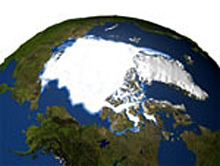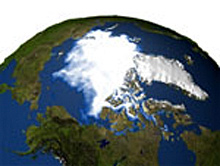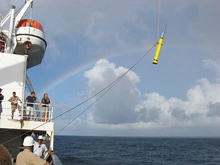Warming of the World Ocean
Scientific Interest in Ocean Heat Content
Most people, when hearing or reading about a warm up of the world ocean, would naturally ask, “Just how much did the temperature rise?” But to scientists who study phenomena like this, the problem is more complex. While they use ocean temperature readings taken from around the globe to conduct their studies on ocean warming, these scientists are interested in learning about the heat content of the world ocean’s enormous mass of water. Heat content is a measure of the heat energy imparted to a body such as a continent or the ocean. Scientists measure heat content in energy units known as joules.


Many citizens and nations worldwide voice concern over global climate change, including increased heat content of the world ocean, claiming rising temperatures are melting the polar ice caps. Images gathered from the Defense Meteorological Satellite Program here show the minimum Arctic sea ice concentration 1979 (left) and 2003 (right). Click images for larger views.
Beginning in the 1970s, scientists at NOAA’s Geophysical Fluid Dynamics Laboratory in Princeton, New Jersey, started computing the annual cycle of ocean heat content. From the outset, scientists in the climate modeling community showed significant interest in the results of this work as a way to validate their general circulation models of ocean-atmosphere interactions.
During the 1990s, when NOAA’s National Oceanographic Data Center expanded its World Ocean Database, scientists started computing ocean heat content because of its possible importance in the Earth's heat balance, especially in diagnosing the Earth’s response to the observed increase in atmospheric greenhouses gases such as carbon dioxide. At that time, climate and atmospheric scientists hypothesized that increased concentrations of atmospheric greenhouse gases could lead to an increase in ocean heat content. However, substantial evidence to verify the hypothesis was not yet available.
Comparing Model Outputs with Ocean Observations

Launching a CTD device off a ships’s fantail. CTD, short for conductivity, temperature, and depth, measures the conductivity and temperature of the water column relative to depth. NOAA scientists who estimated the warming of the world ocean used temperature data from thousands of CTD records. Click image for larger view.
The National Oceanographic Data Center's Ocean Climate Laboratory in Silver Spring, Maryland, set out to test the hypothesis. Researchers at the lab did this by comparing temperature observations from throughout the world ocean from 1955 to 1998. They devised mathematical procedures and statistical tests to compare 5.1 million temperature profiles in the lab's databases. The profiles come from many countries including the United States, Russia, the United Kingdom, Germany, France, Canada, Australia, and Japan and are taken from research ships, naval ships, buoys, or merchant ships.
In 2000, the journal Science published “Warming of the World Ocean,” the first paper to report the results of the NODC ocean warming study. In the article, NODC scientists concluded that the world ocean had potentially absorbed 20 x 1022 joules, and warmed 0.06 degrees Fahrenheit. (They revised the energy absorption figure downward to 14.5 X 1022 in a 2005 paper entitled “Warming of the World Ocean, 1955-2003,” in the journal Geophysical Research Letters.). The temperature increase appears to be very small until we consider that the estimated energy input is equivalent to approximately 10 million thunderstorms, 100,000,000 Hiroshima-size atomic bombs, or burning approximately 1,000 trillion barrels of oil (more than are known to exist)! Put in other terms, the sudden release of this energy from the ocean would warm the bottom 10 km (6.2 mi) of the atmosphere approximately 22 degrees Celsius (40 degrees Fahrenheit).

The graph shows an increase in heat content of the North Atlantic Ocean over a forty-year period. The Atlantic Ocean contributes more of the increase in heat to the world ocean than the Pacific and Indian oceans combined. Click image for larger view.
After publication of this paper, researchers at the National Oceanographic Data Center (NODC) and the Geophysical Fluid Dynamics Laboratory (GFDL) collaborated and obtained good agreement between GFDL’s atmosphere-ocean circulation model estimates of ocean heat content with NODC’s computed estimates for the period 1955-1996. This led to a second paper, “Anthropogenic Warming of Earth’s Climate System,” also published in Science in 2001 which reported these findings. In addition, this paper documented that the world ocean accounted for approximately 80 percent of the Earth’s increase in heat content from 1955 to 1996. These papers were the first time scientists documented quantifiably that the world ocean has warmed during this period, and that ocean heat storage dominates Earth’s heat balance.
These studies are critical to understanding the role of the ocean as part of Earth’s climate and have been cited frequently by the scientific community. In particular, these results play an important role in documenting the Earth’s response to the observed increase of greenhouse gases in the atmosphere since the beginning of the Industrial Revolution in the late 18th and early 19th centuries. Climate models reproduce or verify the observed long-term trend in ocean heat content only when forced by the observed increase in greenhouse gases in earth’s atmosphere. These results have generated substantial interest in the scientific community as these papers have been cited more than 400 times since their publication.
Stimulating Other Climate Investigations

Deploying an Argo floating profiler. These floats are battery-powered and neutrally buoyant so they can drift at depth. Every 10 days, the floats rise to the surface while measuring temperature and salinity. When they reach the surface, the floats transmit these data to satellites, which determine their position. The floats then sink and drift until the cycle repeats. A float's life span is about 150 such cycles or about four years. Click image for larger view.
In 2005, NOAA scientists updated their initial study that confirmed the warming of the world ocean in a paper that has been cited more than 50 times since publication. Other scientists have verified the long-term trend of ocean warming. Additional research stimulated by NOAA’s work shows that the outer skin of the earth’s lithosphere (continents) has warmed and retained as much heat as the earth’s atmosphere during the past 50 years. In addition, NOAA’s work has motivated researchers to further study and quantify the causes of global average sea level rise during the past 50 years. Computing the expected increase of volume of the World Ocean and accompanying rise of sea level based on thermal expansion alone accounts for 25 percent of the observed rise of world sea level. The observed changes in ocean heat content has justified the deployment of Argo profiling floats 1; which will allow routine estimates of ocean heat content on a monthly basis.
1. Argo is a global array of approximately 3,000 free-drifting profiling floats that measures the temperature and salinity of the upper 2000 m of the ocean. This allows, for the first time, continuous monitoring of the temperature, salinity, and velocity of the upper ocean, with all data being relayed by satellite and made publicly available within hours after collection.










